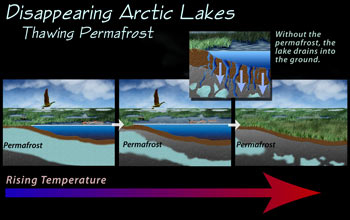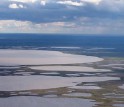News Release 05-093
Arctic Warming May Be a Factor in Demise of Lakes
Loss of waterways also threatens wildlife

Scientists say rising temperatures have led to the disappearance of 125 Arctic lakes.
June 3, 2005
This material is available primarily for archival purposes. Telephone numbers or other contact information may be out of date; please see current contact information at media contacts.
According to researchers, rising Arctic temperatures over the past two decades appear to have thawed the ground enough to allow more than 125 lakes to drain into the soil and vanish. The new finding provides additional evidence that the 20-year-old warming trend documented in the Arctic is physically affecting the landscape. Further, the scientists say, the abrupt draining has the potential to alter entire continental ecosystems as migratory birds and other wildlife depend on the waterways.
A team from the University of California at Los Angeles, the College of Environmental Science and Forestry at the State University of New York and the University of Alaska, Fairbanks, published the findings in the June 3 edition of the journal Science.
Laurence Smith, an associate professor at the University of California, Los Angeles, and primary author of the paper, said most of the affected lakes form atop permafrost, or permanently frozen ground. A solid permafrost prevents the lakes from draining, allowing hundreds of thousands of ponds, lakes and wetlands to dot the Arctic landscape.
He said the team's findings, which were funded by the National Science Foundation (NSF), indicate the current warming may be thawing the permafrost layer and causing lakes to initially grow and expand before seeping into the ground. As temperatures in the region continue to rise, Smith expects this trend to persist and spread northward, resulting in the disappearance of more lakes.
The lakes, Smith noted, are a dominant feature of the Arctic landscape. Their disappearance could have a devastating effect on the living conditions of native people and Arctic wildlife. Migratory birds depend on these lakes as a summertime habitat and they are critical to the feeding and rearing of young.
The researchers tracked changes in more than 10,000 large lakes by comparing satellite imagery from 1972, across 200,000 square miles of Siberian wilderness, with recent satellite data. Their study indicates the declines in total lake number have outpaced lake gains further north, where permafrost has warmed but is still intact.
-NSF-
-
Melting of the Arctic permafrost appears to threaten Siberian lakes.
Credit and Larger Version
Media Contacts
Dena Headlee, NSF, 703-292-7739, email: dheadlee@nsf.gov
Program Contacts
Neil R. Swanberg, NSF, (703) 292-8029, email: nswanber@nsf.gov
Principal Investigators
Laurence C. Smith, UCLA, 310-825-3154, email: lsmith@geog.ucla.edu
Related Websites
UCLA Newsroom: http://www.newsroom.ucla.edu/
The U.S. National Science Foundation propels the nation forward by advancing fundamental research in all fields of science and engineering. NSF supports research and people by providing facilities, instruments and funding to support their ingenuity and sustain the U.S. as a global leader in research and innovation. With a fiscal year 2023 budget of $9.5 billion, NSF funds reach all 50 states through grants to nearly 2,000 colleges, universities and institutions. Each year, NSF receives more than 40,000 competitive proposals and makes about 11,000 new awards. Those awards include support for cooperative research with industry, Arctic and Antarctic research and operations, and U.S. participation in international scientific efforts.
Connect with us online
NSF website: nsf.gov
NSF News: nsf.gov/news
For News Media: nsf.gov/news/newsroom
Statistics: nsf.gov/statistics/
Awards database: nsf.gov/awardsearch/
Follow us on social
Twitter: twitter.com/NSF
Facebook: facebook.com/US.NSF
Instagram: instagram.com/nsfgov



